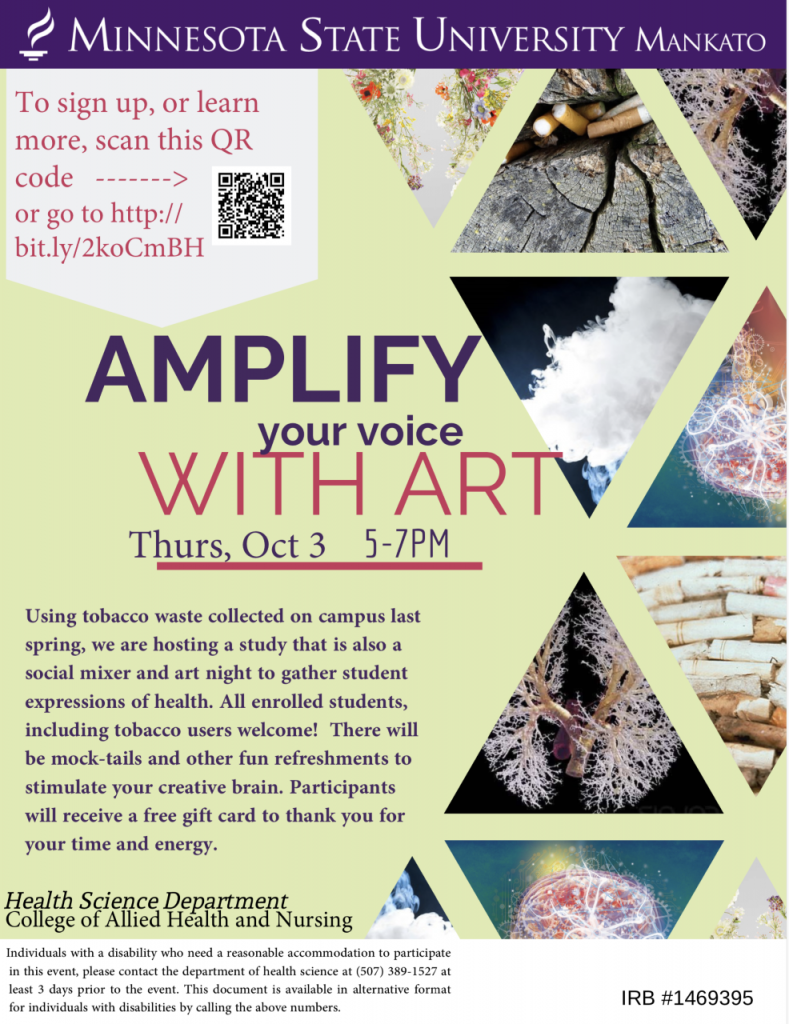Thursday Event Seeks To Raise No Smoking Awareness

To help raise awareness on campus, a Thursday, Oct. 3, event, “Amplify Your Voice With Art,” using cigarette butts collected last spring around campus to create art pieces. Hosted by the Health Science Department, the event uses art to educate and raise awareness to the continuing prevalence of smoking on campus despite the University’s efforts to be smoke free.
The event from 5 to 7 p.m. in Highland Center Room 1700 will include music, mocktails and free food.
By TRAVIS GERLACH, CSU Public Relations Intern and LENNY KOUPAL, CSU Communications Coordinator from reports by the Wall Street Journal and the Washington Post.
EDITOR’S NOTE: A day after this story appeared, the Center for Disease Control reported Oct. 3 that the case count of illness related to vaping rose from 805 to 1,080 with 18 related deaths. All patients reported a history of vaping, and the majority reported using THC-containing products. The CDC says to avoid all vaping products, especially those with THC ingredients.
Major news sources including the Wall Street Journal and the Washington Post released news reports over the past week pointing to the rising instances of lung disease, illness and death associated with vaping – particularly among teens and young adults.
Thus far, 805 cases of lung illness – up from 530 reported a week earlier – have been blamed on vaping. Twelve related deaths have been reported. The connection originated after a Milwaukee hospital determined that multiple cases of an illness presenting itself as pneumonia showed a common instance of vaping.
The discovery drew the attention of the Center for Disease Control which determined that similar illnesses in 46 states have vaping as the common denominator.
While no particular brand of e-cigarettes was targeted, the Washington Post reported that “patients have used many kinds of products with a wide array of ingredients, and some may have been mixed with potentially illicit substances, such as marijuana.”
The Post stated that officials view a chemical exposure as the culprit in the reported cases – many that involve the use of the sought-after effect of THC.
“One substance that is a key focus of investigators is vitamin E oil, known as vitamin E acetate. Experts in the legal marijuana industry have said it has been used to stretch out THC oil that is used to fill vape cartridges. It is colorless and odorless, has similar viscosity to THC oil, and is much cheaper,” the Post reported.
While vitamin E has no harmful effects when ingested or applied to the skin, its molecular structure when inhaled is suspected to cause the kinds of respiratory symptoms patients are reporting – cough, shortness of breath and chest pain.
The Journal stated that half of the cases involved patients 25 years or younger. One in four of the patients were male.
Other reports on the effects of vaping point to nicotine and other harmful ingredients found in e-cigarettes including ultrafine particles that can be inhaled deep into the lungs; flavoring such as diacetyl, a chemical linked to a serious lung disease; volatile organic compounds such as benzene, which is found in car exhaust; and heavy metals, such as nickel, tin, and lead.
Minnesota State Mankato Concerned About Vaping and Smoking As It Reviews Campus No Smoking Policy
A recent newsletter from the office of Provost Marilyn Wells restated the University’s No Smoking policy as it relates to cigarettes and e-cigarettes. The report reminded the campus community that e-cigarettes are among tobacco products banned on all campus grounds by campus policy.
“Vaping is considered a tobacco product (officially by the FDA) and is prohibited by our policy. And also by state law in all indoor public spaces as of August 1, 2019,” added Dr. Mary Kramer, assistant professor at the College of Allied Health and Nursing at Minnesota State University, Mankato.
Kramer received a $15,000 grant from the American Cancer Society to improve and clarify the University’s policy.
“Right now it’s considered a ‘Partial Tobacco Policy’ for many reasons but mostly because there are no consequences for violating the policy,” said Kramer about the University’s current policy
As part of the grant, Kramer is collecting data to help back up why the university needs to improve the policy.
Kramer said that the most revealing result from the survey conducted last spring showed that 84 percent of those surveyed say they were exposed to second-hand smoke on the Minnesota State Mankato campus. The majority – 79 percent – feel that universities have a responsibility to ensure clean air.
